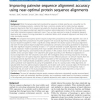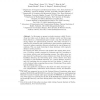57 search results - page 6 / 12 » DBAli tools: mining the protein structure space |
BMCBI
2006
13 years 7 months ago
2006
Background: Since the publication of the first draft of the human genome in 2000, bioinformatic data have been accumulating at an overwhelming pace. Currently, more than 3 million...
NAR
2011
12 years 10 months ago
2011
An essential prerequisite for any systems-level understanding of cellular functions is to correctly uncover and annotate all functional interactions among proteins in the cell. To...
BMCBI
2010
13 years 7 months ago
2010
Background: While the pairwise alignments produced by sequence similarity searches are a powerful tool for identifying homologous proteins - proteins that share a common ancestor ...
KAIS
2000
13 years 7 months ago
2000
Abstract. In this paper we present an index structure, called MetricMap, that takes a set of objects and a distance metric and then maps those objects to a k-dimensional space in s...
ICDM
2005
IEEE
14 years 1 months ago
2005
IEEE
Organizing textual documents into a hierarchical taxonomy is a common practice in knowledge management. Beside textual features, the hierarchical structure of directories reflect...


